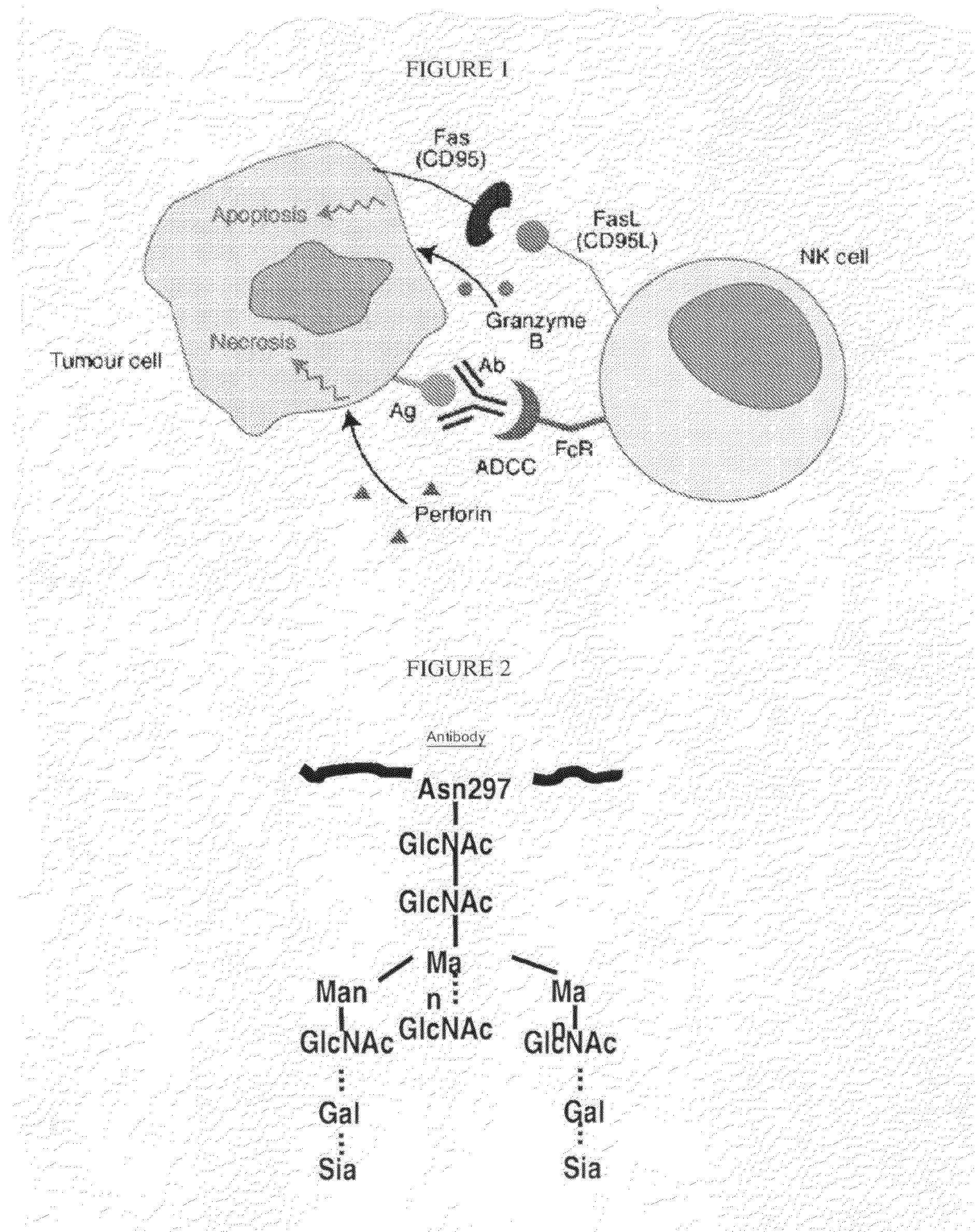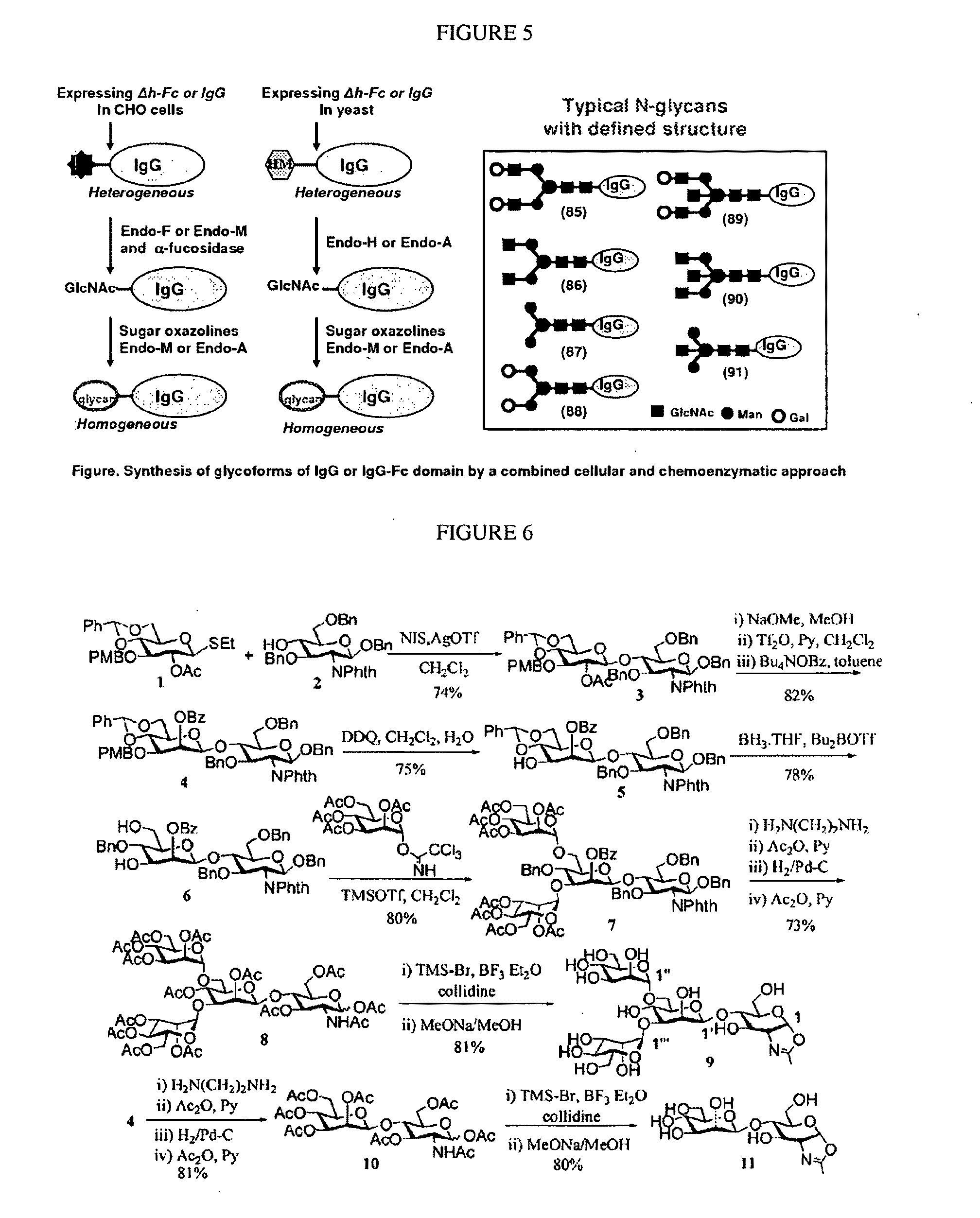Glycosylation engineered antibody therapy
a technology of glycosylation and engineered antibodies, which is applied in the field of glycosylation engineered antibody therapy, can solve the problems of difficult isolation of human igg having a particular glycosylation state from this mixture, interfere with results and data interpretation, and severely impair the adcc and cdc of n-glycan removal, so as to reduce the dose of a marketed mab, improve the effect, and reduce the toxicity
- Summary
- Abstract
- Description
- Claims
- Application Information
AI Technical Summary
Benefits of technology
Problems solved by technology
Method used
Image
Examples
example 1
Detection of FcgRIIIa Receptor (CD16a) and FcgRIIa (CD32) Allelic Polymorphisms
[0086]In order to determine the ability of glycosylation-engineered mAbs to induce ADCC in a patient with diverse genotypes or to determine the responsiveness of non-glycoengineered mAbs, PCR based strategies, for example, are used to characterize allelic variants for position 131 of FcgRIIa and position 158 of FcgRIIIa. First, genomic DNA was isolated from human tumor cells lines, human saliva, human PBMC or paraffin embedded tissue and was used as a template for PCR amplification.
[0087]A. Detection of the FcgIIIa Receptor (CD16a) Allelic Polymorphism Using PCR Amplification and Restriction Enzyme Digestion.
[0088]Primer design is based on sequences available in GenBank (accession no. X52645 for FcgRIIIa, Nieto et al, 2000). This procedure uses primers that introduced a novel RsaI site into one end of all amplified products and a second primer that created a novel StyI (or Eco130 I) site in one of the two...
##ic example 2
Prophetic Example 2
Homogenous Preparation of Antibodies
[0093]To obtain a homogeneous preparation of mAbs with a particular glycosylation state, a combined high-yield cellular expression with in vitro glycosylation engineering using a chemoenzymatic transglycosylation system is utilized [27-30]. Combined with the power of chemical synthesis of oligosaccharide oxazoline substrates for the endo-enzymes, this approach allows for the preparation of an array of defined glycosylation states (natural or unnatural) of mAbs or their IgG-Fc domain, which, in turn, allows for a systematic analysis of the structure-activity relationships of IgG glycosylation and ADCC activity. Following the pioneering work of Jeffries et al., use of the hingeless human IgG-Fc, the delta-h-Fc (aa 231-447) as a model system, in which the hinge region of Fc was deleted, is also used [7, 31]. Using this truncated Fc form rather than a whole human antibody IgG or IgG-Fc as a model system greatly simplifies the synthe...
example 3
Example Design and Synthesis of Carbohydrate Oxazolines
[0095]ENGases are a class of endoglycosidases that hydrolyze the beta-1,4-glycosidic bond in the core N,N′-diacetylchitobiose moiety of N-glycoproteins to release the N-glycans. However, some ENGases, such as Endo-A from Arthrobacter protophormiae and Endo-M from Mucor hiemalis, possess transglycosylation activity and are able to transfer the releasing N-glycan to a GlcNAc-peptide acceptor to form a new glycopolypeptide. Endo-A and Endo-M can transfer a large intact oligosaccharide to a GlcNAc-peptide acceptor in a single step to form a new glycopolypeptide, thus allowing a highly convergent glycopolypeptide synthesis without the need of protecting groups. The chemoenzymatic method suffers with a low transglycosylation yield (generally 5-20%), product hydrolysis, and the limitations of using only natural N-glycans as the donor substrates. To solve these problems, we used synthetic oligosaccharide oxazolines, the mimics of the pr...
PUM
| Property | Measurement | Unit |
|---|---|---|
| Biological properties | aaaaa | aaaaa |
| Cytotoxicity | aaaaa | aaaaa |
| Affinity | aaaaa | aaaaa |
Abstract
Description
Claims
Application Information
 Login to View More
Login to View More - R&D
- Intellectual Property
- Life Sciences
- Materials
- Tech Scout
- Unparalleled Data Quality
- Higher Quality Content
- 60% Fewer Hallucinations
Browse by: Latest US Patents, China's latest patents, Technical Efficacy Thesaurus, Application Domain, Technology Topic, Popular Technical Reports.
© 2025 PatSnap. All rights reserved.Legal|Privacy policy|Modern Slavery Act Transparency Statement|Sitemap|About US| Contact US: help@patsnap.com



